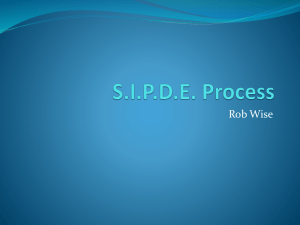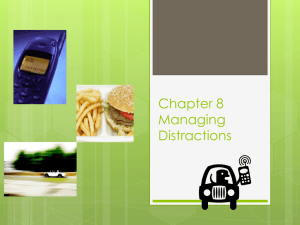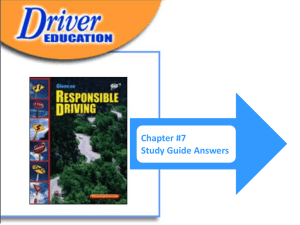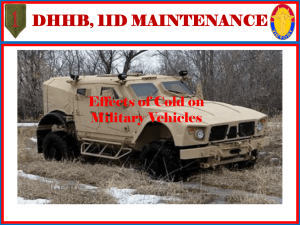AMSTI MOTION AND DESIGN PPT Lessons 6-last
advertisement
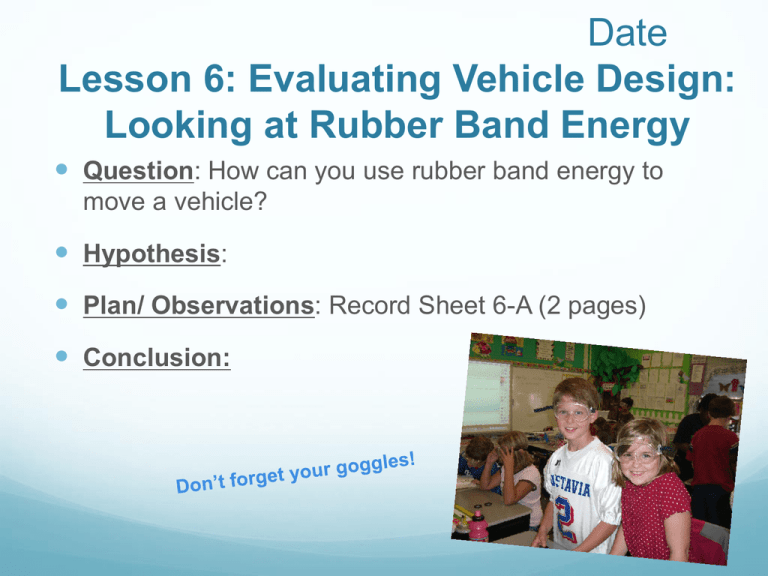
Date Lesson 6: Evaluating Vehicle Design: Looking at Rubber Band Energy Question: How can you use rubber band energy to move a vehicle? Hypothesis: Plan/ Observations: Record Sheet 6-A (2 pages) Conclusion: Date Lesson 7: Testing the Effects of Rubber Band Energy Question: How will the number of turns in the rubber band affect the distance the vehicle travels? Hypothesis: Plan/ Observations: Record Sheet Lesson 7 Photos Lesson 7 continued Conclusion/Reflection: Next Steps/ New Questions: Date Lesson 8: Evaluating Vehicle Design: Looking at Friction Question: How does friction affect the motion of your vehicle? Hypothesis: Plan/ Observations: Record Sheet 8-A (3 sheets) Card One: Card Two: Card Three: Conclusion/Reflection: Friction is the force that resists movement between two objects that are touching. It slows down movement. Next Steps/ New Questions: Date Lesson 9: Designing and Building a Vehicle with a Sail Question: What happens when you attach a sail to your vehicle? Hypothesis: Plan/ Observations (Write and draw): Conclusion/Reflection: Next Steps/ New Questions: Date Lesson 10: Testing the Effects of Air Resistance on a Vehicle’s Motion Question: What is air resistance? How does air resistance affect the motion of a vehicle with a sail? Hypothesis: Plan/ Observations: Chart Lesson 10 continued Conclusion/Reflection: Air resistance is the force of friction on a vehicle as it moves through the air. It opposes a vehicle’s motion and slows it down. Engineers refer to air resistance as drag. Designs that minimize drag are known as aerodynamic (able to move through the air with as little air resistance as possible). For example, many automobile shapes are curved without sharp corners. Next Steps/ New Questions: Date Lesson 11: Building a Propeller-Driven Vehicle Question: What do you know about propeller-driven vehicles? How can you build a propeller-driven vehicle? Hypothesis: (Brainstorm and draw). (Show pictures on next slide.) Examples of Propeller Driven Vehicles Lesson 11 Technical Drawing SI pg. 48 Propeller-Driven Vehicle Pieces 6 Yellow Connectors 6 Green Rods 6 Red Connectors 2 Orange Connectors 1 Blue Rod 3 Red Rods 4 Grey Rods 4 Small Wheels 4 Tan Connectors 1 White Connector 4 Yellow Rods Propeller-Driven Vehicle Propeller-Driven Vehicle Front View Top View Side View Rear View Lesson 11 continued Observations: Chart Lesson 11 continued Conclusion/Reflection: Propellers create a force that moves airplanes and boats forward. Even when an airplane is on the ground, the force from the spinning propellers enables it to taxi on and off the runway. Next Steps/ New Questions: Date Lesson 12: Analyzing the Motion and Design of a Propeller-Driven Vehicle Question: How will modifying the propeller driven vehicle affect its performance? Record Sheet 12-A (2 sheets) All parts of the scientific method are embedded in the Record Sheet. Conclusion/Reflection: Next Steps/ New Questions: Date Lesson 13: Looking at Cost Question: How can you modify your propeller-driven vehicle to make it more cost-effective? Hypothesis: Plan/ Observations: Record Sheet 13-A Conclusion/Reflection: Cost-effective is the ability to produce the best results for the least amount of money. You can reduce vehicle cost by: -taking off the big pieces that cost a lot -replacing larger wheels with small wheels -taking off fancy pieces that are just for looks -reducing the number of pieces. Next Steps/ New Questions: Date Lesson 14-16: Our Final Design Challenge Question: How can you design and refine a vehicle to meet a specific requirement? (See Design Challenge) Hypothesis: Plan/ Observations: Record Sheet 14-A Conclusion/Reflection: Next Steps/ New Questions: (Reading Selection SI p.6061) Design Challenge Presentations Dueling Flipchart Game 1. A push or a pull ________________________ force 2. Energy in motion is called _____________ kinetic energy. 3. Force that resists movement between two objects that are touching _______________________ friction 4. The force exerted by a stretched object, such as a spring tension 5. An original model of a design _______________________ prototype 6. A detailed plan or drawing that shows how something is designed ____________________________ blueprint 7. Stored energy is ______________ potential energy Slows down/ stops motion 8. How does friction affect motion? ________________________ 9. The tendency that any moving object has to keep going unless something stops it. _______________________ momentum inertia 10. _____________: An object at rest stays at rest; an object in motion stays in motion Newton’s Laws of Motion Three laws that describe how objects move in relation to the forces acting on them. 1. An object in motion tends to remain in motion, and an object at rest tends to remain at rest (Inertia). 2. To move a mass, you have to have force. Force equals mass times acceleration. 3. Action/ Reaction: For every action, there’s an equal and opposite reaction.

